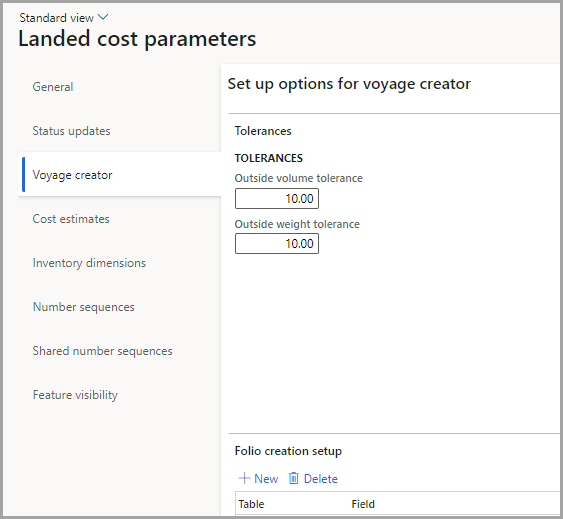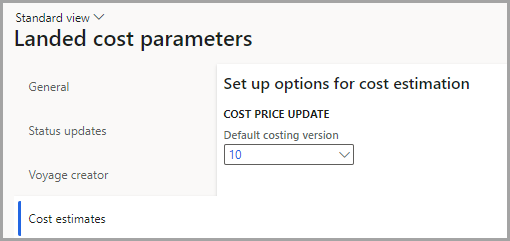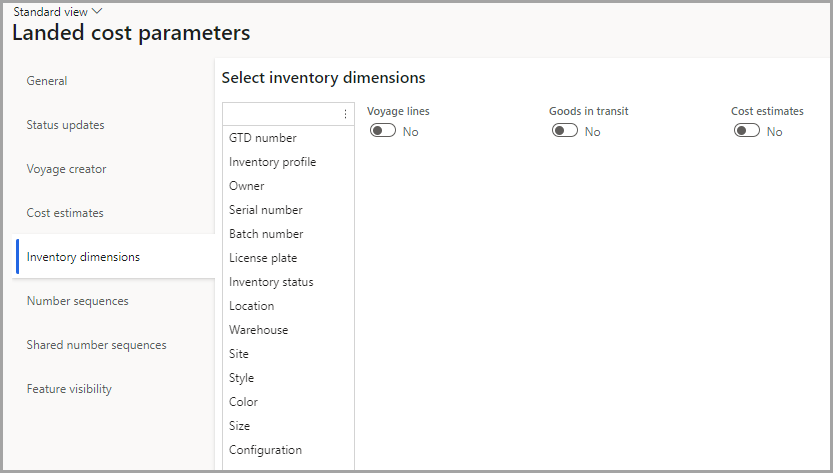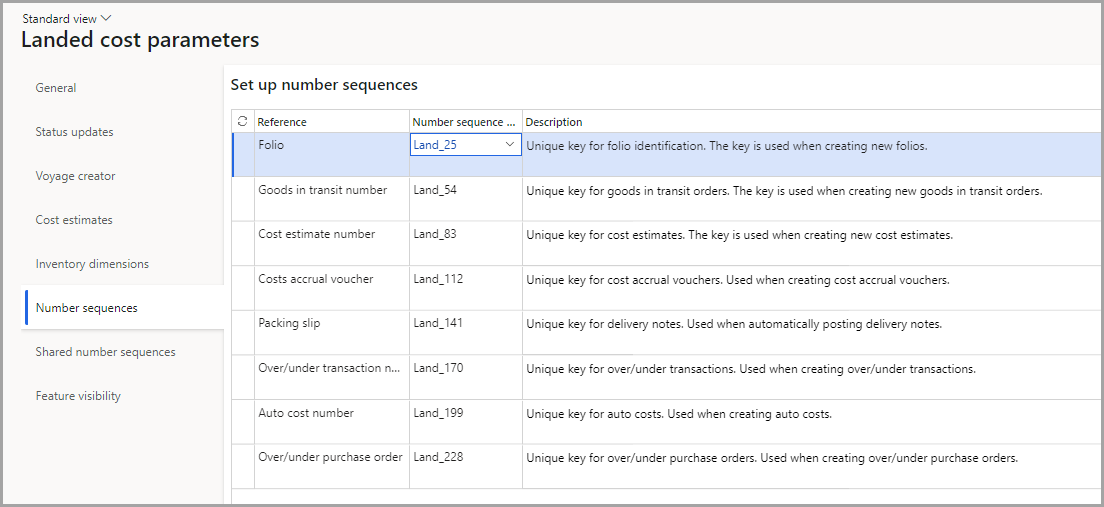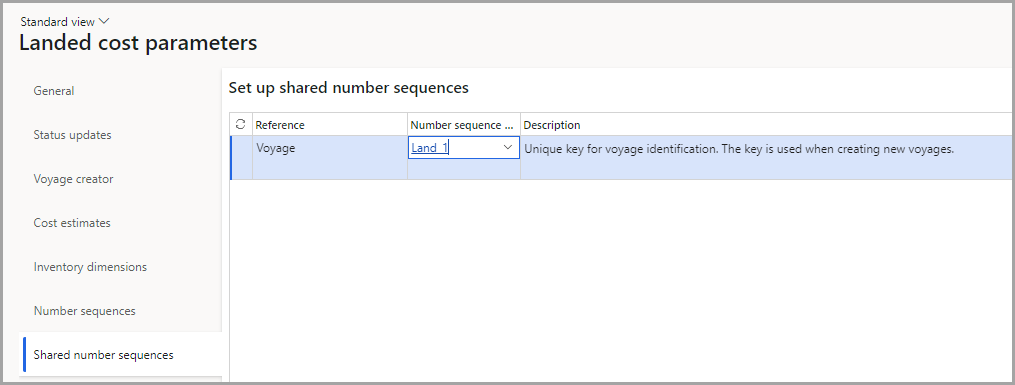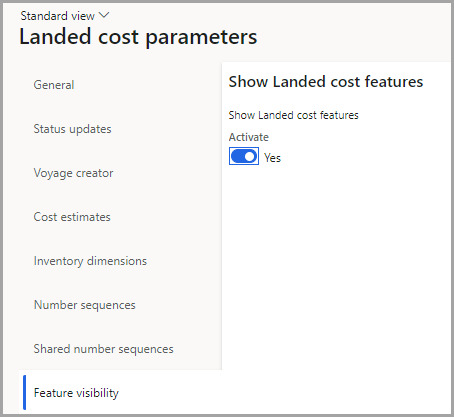Landed cost parameters
The Landed cost parameters page is where you set up the general information and configuration options that you want to use throughout the Landed cost module for posting, status updates, number sequences, and behavior. After you've set up the parameters, share them with other legal entities, and then an administrator can handle updates.
You can access the Landed cost parameters page by going to Landed cost > Setup > Landed cost parameters.
Because the parameters are essential to defining your landed costs, the following sections explain this page section-by-section.
General tab
The first section in the Landed cost parameters page is the General tab, which contains the following FastTabs:
General - Sets the basis for some general parameters that are related to voyages.
Costing - Tells the system how to handle various situations that are related to voyage costs.
Validation - Tells the system how to handle or validate a situation when certain anomalies occur.
Defaults - Sets the basic defaults for voyages.
General FastTab
The General FastTab includes the following fields:
Use shipping rate - Determines which default shipping rate that you want to use for your voyages. Most companies have a predetermined shipping rate that's used for a specific period to estimate the cost of items that are priced in multiple currencies. Select Yes if you want to use the established shipping rate for voyages.
Exchange rate type - Determines which exchange rate is used in multicurrency calculations for a voyage and their associated costs. From the dropdown menu, select which rate should apply to all voyages.
Update purchase order quantity - Determines what happens when a user attempts to change the quantity on a purchase order line that is part of a voyage. Select one of the following actions from the dropdown menu:
Accept - The voyage quantity is automatically updated.
Warning - A warning is displayed, and the quantity is updated.
Error - An error warning is displayed and prohibits the user from modifying the purchase order. For the user to proceed, they must remove the order line from the voyage.
Automatically update number of cartons - Determines how the cartons on a voyage are displayed.
If this toggle is set to Yes, all cartons will be combined and displayed at the voyage and container level.
If this toggle is set to No, the number of cartons is initially set to 0 (zero) and will require that a user manually adjusts them as needed.
Costing FastTab
The Costing FastTab includes the following fields.
Posting specification - Determines how the value adjustment will appear in the ledger. Use the dropdown menu to select one of the following options:
Total - The total amount will be posted to the ledger.
Item group - Each item group will post as an amount to the ledger, providing more detail.
Item number - Each item number will post an amount to the ledger, which provides the most detailed information.
Allow zero costs - Determines if you want to allow zero costs to be part of the voyage.
If this toggle is set to Yes, it will allow a voyage to contain items at a zero cost. In this case, a 0 (zero) price is assigned to that cost area, thus allowing the vendor cost invoice to be processed after the voyage is received.
If this toggle is set to No, the system generates an error message and prevents the user from posting an invoice or purchase order with a 0 (zero) value for a projected cost. This option provides you with a more accurate estimate versus assuming zero costs. (Recommended)
In this case, the user has the following options:
Manually change the estimate.
Change how the auto cost works.
Pull in the new value.
Delete the cost if it doesn't apply.
Adjustment posting date - When you post a voyage cost invoice to accounts payable, the settlements table (inventory adjustments) is updated as well. The adjustment posting date determines which default date will appear on the Select voyage costs page in the invoice journal:
Transaction date - The posting or journal date.
Purchase order invoice date - The financial posting date of the item (purchase order) invoice.
Selected date - The user specifies the posting date. If the Selected date field is clear, the user will receive an error message when posting the cost invoice.
Use purchase order invoice - Determines if you want to use the same number as the purchase order invoice for cost accrual transactions.
- If this toggle is set to Yes, cost accrual transactions use the same voucher number as the purchase order invoice.
- If this toggle is set to No, the system will use the next available cost accrual voucher number on the Landed cost parameters page in the Number sequences tab.
Note
This option has no effect unless the Post to charge account in ledger option on the Invoice tab of the Accounts payable parameters page is set to Yes.
Block manual posting to clearing account - Determines which transactions are posted to clearing accounts.
If this toggle is set to Yes, it will stop transactions that aren't linked to a voyage from posting to clearing accounts. You can link costs to a voyage by going to the Action Pane of the vendor invoice journal and selecting Functions > Select voyage costs. (Recommended)
If this toggle is set to No, all transactions will be posted to the clearing accounts.
We recommend that you set this toggle to Yes to ensure the proper voyage and clearing account settlement.
Use cost type charge accrual account - Determines if the charge accrual account will be used to accrue costs as an expense. Select Yes if you want the system to use the charge accrual account that is defined on the Cost type codes page to accrue costs as an expense.
Note
This option is only applicable if the Post to charge account in ledger option is set to Yes on the Invoice tab on the Accounts payable parameters page.
Post adjustments as variance - Determines how the variances between estimated costs and actual costs are handled.
If this toggle is set to Yes, the inventory adjustment transactions with variances will be posted to a variance account, thus overriding the standard functionality.
If this toggle is set to No, the inventory adjustment transactions with variances will be handled according to the costing method and cost type code settings. For standard costs, the amounts will be posted to the variance account. For moving weighted average (MWA), the amounts will be posted to the variance account or inventory. |
Note
This option is only applicable if the Post to charge account in ledger option is set to Yes on the Invoice tab on the Accounts payable parameters page.
Validation FastTab
The Validation FastTab contains the following fields.
Multiple cost invoices - Determines what happens when multiple invoices are processed for the same miscellaneous charge for a voyage, folio, or container.
Accept – This setting allows for multiple invoices.
Warning – A warning message appears.
Error – An error message appears.
Multiple vendors per folio - Determines how the system will handle purchase orders from multiple vendors for a folio.
Accept – This setting allows for purchase orders from different vendors.
Warning – A warning message appears, but the system will still add the purchase orders from different vendors.
Error – An error message appears and prevents different purchase orders from being added.
Note
Your customs broker or local laws might require that this field has a specified value.
Multiple mode of delivery tolerance - Determines how the system handles a purchase order that uses a different delivery method than initially specified in the voyage.
Accept – The purchase order is added.
Warning – A warning message appears but allows the purchase order to be added.
Error – An error message appears and prevents the purchase order from being added.
Multiple warehouse tolerance - Determines how the system will handle a voyage that contains several order lines that must be delivered to separate warehouses and split among multiple purchase orders.
Accept – This setting allows for the action.
Warning – A warning message appears.
Error – An error message appears.
Missing volume - Determines what happens when a user adds an item without a volume.
Accept – The item is added.
Warning – A warning message appears.
Error – An error message appears.
We recommend that you use Warning or Error to calculate or allocate charges based on volume.
Services provider without voyage cost - Determines what happens when an invoice for a service provider that isn't associated with a voyage is processed.
Accept –The invoice is processed.
Warning – A warning message appears. (Recommended)
Error – An error message appears.
Defaults FastTab
The Defaults FastTab will set default parameters for the following fields:
Journal name Select which journal that the Create arrival journal function will use.
Voyage status Select the default status for a voyage before a user can create a rental shipping container. (In general, this scenario occurs when the goods are in transit or at the dock.)
Journey template Select which journey template to use when you’re creating new rental shipment containers. Most journey templates include rental costs.
Movement Select which movement journal to use when the over/under amount falls within the defined range. The Offset account field for this movement journal must contain a value.
Transfer Select which transfer journal to use when you’re processing an under-delivery and transferring the short-receipt quantity to a warehouse.
Disable non-voyage purchase orders Select Yes if you want to disable the Landed cost over/under delivery functionality for purchase orders that aren't associated with a voyage.
Disable non goods in transit purchase orders Select Yes if you want to disable the Landed cost over/under delivery functionality for purchase orders that don’t use the goods in transit.
Goods in transit over receipt grace period Specify the number of days to process extra receipts for a shipping container after the initial receipt comes in.
Status updates tab
With the Status updates tab, you can set up the values that represent the voyage's status. After you've specified the values, they'll be added automatically to voyages through the voyage tracking and periodic batch processes. Additionally, you can manually update them by opening a specific voyage page, going the Manage tab on the Action Pane, and then under the Voyage update group, selecting the status that you want to change.
You can add as many voyage status values as you need; however, you need to designate the following fields as being used for a special purpose on the Status updates tab of the Landed cost parameters page. The following table summarizes the available fields.
| Field | Description |
|---|---|
| Costed | Select the status that defines when the voyage is finalized. |
| In transit | Select the status that defines when the voyage is in transit. |
| Ready for costing | Select the status that defines when the voyage is ready for costing. Essentially, all stock purchase invoices and voyage cost invoices where the Credit on the voyage cost field is set to Vendor will be processed. Voyages that fail the process will have the Ready for costing status. |
| Pre-costed | Select the status that defines when a voyage is pre-costed. Pre-costed means that a previously costed voyage has added a new cost transaction, such as an unexpected demurrage charge or a new freight invoice. This status is applied when a new voyage cost is added to a costed voyage. |
Voyage creator tab
The Voyage creator tab includes the following sections.
| Field | Description |
|---|---|
| Tolerances | Defines the thresholds above which goods are considered over-volume and overweight by setting the limits in the Outside volume tolerance and Outside weight tolerance fields. Each field's value is stated as a percentage of the shipping container's maximum volume or weight. After you've entered the value, a warning will appear if goods that are added to the Voyage editor page exceed the value. The recommended value should be between 5 to 10 percent of the maximum volume or weight. |
| Folio creation setup | During the voyage creation process, the system can generate multiple folios. This section defines when a new folio should be created by adding a new row and selecting the appropriate table and field. After you’re finished, the system verifies the specified table and field and then creates a new folio for each unique field value. |
Cost estimates tab
The Cost estimates tab contains the Default costing version field, which defines the default costing version for the Item cost price update period task. Keep in mind the following parameters:
This setting is only applicable when the costing method is Standard costing.
You might need to adjust this setting whenever a new fiscal year begins.
Inventory dimensions tab
The Inventory dimensions tab defines which available inventory dimensions will appear by default on various pages in the Landed cost module.
From the list, select a dimension and then select Yes for the Voyage lines, Goods in transit, and/or Cost estimates options on each page where that dimension should be displayed by default. Then, as needed, repeat this process for the other dimensions.
The settings on this tab determine the default dimensions for each legal entity's allocated page. However, users who are working on one of the selected pages can change the default measurements by going to Inventory > Display dimensions in the Action Pane.
Number sequences tab
The Number sequences tab lists each type of reference number sequence that's required by the Landed cost module but not shared across legal entities. Go to the reference line, and in the Number sequence column, select a number sequence code from the dropdown list to make changes.
Note
If the setup involves a multi-company configuration, each company or legal entity must have a different number sequence.
Shared number sequences tab
The Shared number sequences tab lists each reference number sequence that is shared between legal entities for the Landed cost module. In this case, only one shared number sequence is used for the voyage ID when you create a new voyage.
Users can view all voyages across all legal entities on the All voyages page. Users must be in the selected record's legal entity to update and process a voyage.
Feature visibility tab
Landed cost enhances numerous frequently used pages in Microsoft Dynamics 365 Supply Chain Management by adding features (fields and functions). These pages include vendor master data, released items, purchase orders, transfer orders, and warehouse configuration. If you're using landed costs, make sure that you make those features visible in all locations to take advantage of them.
Set the Activate option to Yes on the Feature visibility tab to make Landed cost features visible wherever they're available.
Set the Activate option to No if you want the features on standard pages outside of Landed cost to be hidden. Even if the option is set as No, the module, including the Landed cost parameters page, will be accessible to people who have the appropriate rights.
Procurement and sourcing parameters for Landed cost
The Procurement and sourcing parameters page contains a few configuration options that are beneficial when you're using the Landed cost module. The Update order lines dialog, which you can access from the Procurement and sourcing parameters page, allows you to select how the purchase order lines should be updated automatically when the purchase order header is modified.
Follow the steps to set up the procurement and sourcing parameters.
Go to Procurement and sourcing > Setup > Procurement and sourcing parameters.
On the General tab, select Update order lines.
The Update order lines dialog will display a list of fields on the order header that can be updated automatically on related order lines. Set one of the following values for each field in the list:
Always - The order lines are automatically updated when the order header is changed.
Never - The order lines aren't updated when the order header is changed.
Prompt - The user is prompted to select whether the order lines should be updated.





